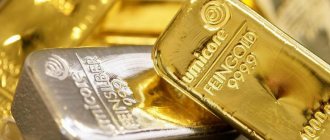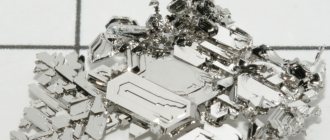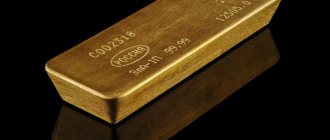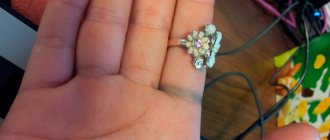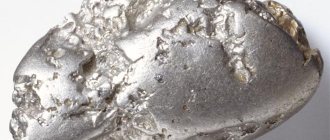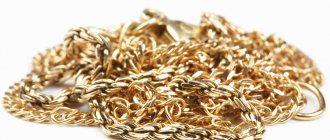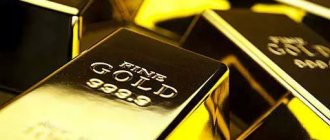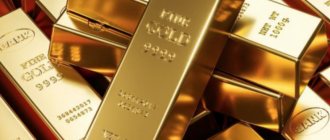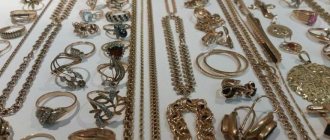What it is?
Noble metals are distinguished from other elements by their ability to maintain their molecular structure under the influence of an unfavorable environment.
They cannot be decomposed, and the melting point of these elements is extremely high. They do not react with oxygen and do not produce oxides. Alloys with precious metals can only be obtained through complex chemical manipulations using the strongest reagents. The mass share of precious metals in the total production of natural resources is very small, which explains the high price of these elements, as well as their special status.
A complete list of names of precious metals was prescribed in 1998 in the Federal Law “On Precious Metals and Precious Stones”. According to Russian legislation, platinum and five of its group metals, as well as the popular silver and gold, are considered precious.
Interesting and surprising
- It is believed that aurum is such a rare element that it is possible to find more iron in sixty minutes than a given yellow metal has been found in the entire history of its mining. Meanwhile, this is more than one hundred and sixty thousand tons! The most remarkable thing, by the way, is that the vast majority of this amount was discovered in South Africa.
- Gold can be dissolved in a combination of nitric and hydrochloric acids. This “union” is called “royal vodka”.
- The word "silver", just like its British and German synonyms, comes from the ancient Indian word "sarpa", the meaning of which is the moon and the sickle.
- At the end of the twenties of the nineteenth century in Russia, platinum was two times cheaper than silver (now it is about a hundred times more expensive).
- The largest silver nugget weighed almost one and a half thousand kilograms.
- The ancient Egyptians believed that gold was divine particles. The pharaoh had the exclusive right to own them.
- Previously, Olympic medals were made of pure gold (at the beginning of the twentieth century), but now they are only coated with this noble metal - no more than six grams per medal (and in the medals awarded at the 2012 Olympics in London, the gold content does not exceed one percent ).
- Our country is a world leader in the extraction and supply of one of the platinum group metals – palladium.
- Silver in its pure form is found less frequently than gold. Nevertheless, throughout the entire globe there is much less gold than its silver “colleague”.
- In its pure form, gold is very soft. So much so that it can be easily and effortlessly scratched even with fingernails.
Now light has been shed on the question of which metals are noble, and it is clear for what properties and for what reason they are called so.
Which metals are noble and their properties?
This group of metals received the name “noble” due to their special characteristics. Depending on the variety, their physical and chemical properties may manifest themselves to varying degrees, but they always remain unique.
Rhodium
Rhodium is a member of the platinum group. It is a light metal and has a pale blue color. It is distinguished by a high degree of hardness and, at the same time, fragility.
Valued for its high reflectivity and resistance to chemical attack. Rhodium can only be oxidized with hot sulfuric acid. The melting process begins when heated to almost 2000 °C.
Platinum
Because of its white luster, platinum, discovered in the mines of America, was originally called “silver.” Only in 1751 platinum received the status of a precious metal, and its value instantly surpassed the then known silver and gold. It has high ductility and can be easily forged (which is why it is loved by jewelers). At the same time, platinum is harder than gold, refractory, resistant to chemical influences, and not subject to oxidation.
Gold
Like platinum, it has good ductility and malleability, but has lower melting points. Reacts only with aqua regia, invulnerable to alkalis, salts and acids. In nature, specimens of pure gold with a pronounced yellow color and characteristic shine are rarely found. Most often, miners encounter green faded ore.
Osmium
The most refractory of the noble metals. The melting point reaches 2700 °C. In addition, osmium does not dissolve in acids. External characteristics are white and hard. Belongs to the group of heavy metals.
Iridium
Like osmium, it is a heavy metal. The most durable, dense, refractory and insoluble in acids, gray-white in color. The melting point is slightly lower than that of osmium and is 2454 °C.
Ruthenium
In terms of external characteristics, ruthenium can easily be confused with platinum. The noble metal resembles iridium in its melting point and has increased strength and density. It is interesting that only ruthenium and osmium form water-soluble cakes under the influence of alkali, oxidizing agent and high temperatures.
Palladium
Soft, malleable, white with a silver tint. When heated to 860°C, palladium forms oxides, but becomes pure again as the temperature rises further. The melting point is 1554 °C.
Silver
Among the noble metals, silver has the lowest density and a relatively low melting point - 960 ° C. It is best forged and serves as an excellent heat and electrical conductor. It practically does not react with acids, but darkens under the influence of hydrogen sulfide, which is part of the atmosphere.
List of semi-precious metals
In jewelry production and instrument making, metals are actively used that are not essentially precious, but have a certain value. They are conventionally called semi-precious. Among the most popular types are the following:
- titanium;
- tungsten;
- cupronickel
Their price fluctuates in the average price range and does not exceed $2 per gram.
List of precious metals
The following precious metals are known:
- Gold.
- Silver.
- Platinum.
- Rhodium.
- Osmium.
- Iridium.
- Ruthenium.
- Palladium.
Some scientists identify another element that can be classified as a noble metal - technetium. However, due to its radioactivity, it is not included in the general classification.
Each of the materials occurs in nature either in the form of nuggets or as part of ores or alloys. There are not so many deposits of precious metals throughout the Earth, so their development is carried out under the strict control of those state enterprises on whose territory they are located.
History of discoveries
Gold and silver nuggets were discovered by mankind several thousand years ago, that is, before the advent of our era. The development of their natural deposits was successfully carried out on the territory of almost the entire globe back in ancient times.
Somewhat primitive devices and mining methods did not prevent ancient people from achieving their goals and penetrating into the bowels of the earth. The resulting gold and silver were melted down and processed. They were used to produce a wide variety of items. This is evidenced by historical information and various products made from these metals discovered during archaeological excavations of ancient burials.
Platinum "silver"
Unlike gold and silver, the third main noble element - platinum - was discovered by people only in the 16th century. Heavy white nuggets that did not melt well were found by Spanish colonizers as impurities in gold deposits in New Granada. Due to its external similarity to silver (plata in Spanish), the discoverers nicknamed the discovered metal the word platina, which literally means “little silver” in Spanish.
Before the discovery of the Spaniards, platinum, of course, existed and was even known to people. It was called white gold and was used to make counterfeit gold coins and jewelry. As a result of similar frauds that swept across the world, this metal was officially declared prohibited, as a result of which it began to be drowned in the depths of the sea.
In the 16th century, the Spaniards rediscovered the precious metal and rehabilitated it. But despite this, the first description of platinum from a scientific point of view was made only in the 18th century by the English scientist William Watson.
Other representatives of the group
The remaining representatives, the platinum group elements, were discovered one after another in the 19th century. They perfectly symbolize the era of scientific research and discovery.
Rhodium and palladium were obtained through chemical experiments by the Englishman William Hyde Wollaston in 1803. Exactly a year later, osmium and iridium were discovered in the same way, but by another English chemist - Smithson Tennant.
The history of the discovery of ruthenium is longer than that of its “relatives”. It was first extracted from platinum ore in 1808 by the prominent Polish scientist Andrzej Sniadecki. The scientist gave the resulting new chemical element the name Vestia.
Under this name, the metal existed until 1844, when a professor at the University of Kazan, Russian scientist Karl Klaus began a large-scale study of this element. After completing a comprehensive study, Klaus renamed the substance ruthenium - in honor of Great Rus'.
Main characteristics and features
So, the eight existing noble metals are united by similar physical and chemical properties, which, in addition to resistance to oxidative and corrosive processes, include:
- softness;
- high plasticity;
- incredible strength;
- excellent thermal conductivity;
- high refractoriness (except for silver and gold);
- good ductility;
- excellent electrical conductivity.
Also, among the characteristics of substances of the noble category, it is worth especially noting their beautiful appearance. Thanks to the highest chemical resistance, products made from such materials retain their attractive, shiny appearance for a very long time.
For comparison, the most striking counterexample is copper. The initial appearance of products made from this base metal is practically not inferior to jewelry in terms of bright shine and beauty. But the attractive appearance disappears very quickly - upon contact with air, the element reacts and the oxidation process begins. As a result, a kind of film or, in other words, plaque is formed on the surface of the metal, which is why the product becomes dull and changes its original shade.
Representatives of the precious metals of the noble group constitute a single category of elements. But, of course, each of them has its own individual characteristics.
Gold (aurum)
A truly unique element is the only metal in existence that, in the form of a pure substance, has such a bright, expressive yellow color. The chemical resistance of gold is noticeably higher than that of its “comrades” in the noble category.
Even such well-known destroyers as:
- alkalis;
- salt;
- acids;
- high temperatures;
- moisture.
The density of gold is 19.3 g/cm3. This substance is one of the densest and heaviest among metals. The melting point of the metal exceeds a thousand degrees Celsius.
Silver (argentum)
This light gray metal stands out among its peers due to its excellent reflectivity. Silver, of course, is inferior in weight to gold. The same applies to density - it reaches only 10.5 g/cm3. The melting point is 962 degrees Celsius.
There are two types of acids with which silver reacts:
- salt;
- fluorescent
Resistant to moisture. But it darkens under the influence of hydrogen sulfide in the air.
Platinum and “subsidiary” representatives
A worthy rival to gold for the title of heaviest metal. The density of platinum is 21.5 g/cm3. This white-silver shiny substance melts at a temperature of 1773 degrees Celsius.
Representatives of the platinum group and their individual properties:
- Palladium (palladium). Unlike other noble representatives, under certain conditions this silver-colored substance still oxidizes. These conditions consist of heating in the temperature range of 300−860 degrees. However, if you exceed the upper threshold, the resulting oxide deposit will disappear, and the metal itself will become even lighter. The density of the substance is 12 g/cm3. And palladium melts at a temperature of 1554 degrees Celsius.
- Rhodium. The bluish substance has good reflectivity almost on par with silver. A hard but rather brittle metal. Its density is 12.4 g/cm3. The temperature required to melt rhodium is 1962 degrees Celsius.
- Ruthenium. Outwardly, it is almost identical to platinum, but in its properties and characteristics it is close to rhodium. In particular, this concerns density. In terms of melting point, among all the noble group metals it is second only to osmium and iridium. For ruthenium it is 2330 degrees Celsius.
- Iridium. The gray-white substance is identical in properties to ruthenium and rhodium. But in terms of density it surpasses even platinum - for iridium this parameter is 22.4 g/cm3. In terms of melting point, this metal is one of the top three among the elements of the noble group (together with ruthenium and osmium). Iridium melts at 2466 degrees Celsius. This substance is the most resistant metal. It is not affected by acids, salts, or any chemical elements.
- Osmium. The white substance is completely impossible to dissolve in acid. This is the absolute champion among noble substances both in heaviness and density, and in melting point. The latter in osmium reaches 3035 degrees Celsius, and the density is 22.5 g/cm3.
Signs of nobility and classification of elements
It is very simple to understand which metals are called noble and which are considered basic or, in other words, base. This status is determined by the properties they possess. Substances that are classified as noble metals do not oxidize and are not subject to corrosive effects. These characteristic features strikingly distinguish them from other elements - all other metals cannot boast of such durability, and therefore are considered base.
Without exception, all representatives of the noble category also have the status of precious ones. Belonging to the latter is due to the rarity of these substances. The list of noble metals includes eight elements :
- gold;
- silver;
- platinum;
- iridium;
- osmium;
- palladium;
- rhodium;
- ruthenium.
Substances from the first three are considered the main metals of the noble group. The five others belong to the so-called daughter elements of platinum. Platinum representatives are often divided into two groups :
- light metals;
- heavy metals.
The former include palladium, rhodium and ruthenium. The latter include iridium, osmium and platinum itself.
Some scientists consider another ninth representative to be noble - the chemical element technetium. But most experts do not support this point of view - this metal, which is extremely rare in nature, has a fair amount of radioactivity, so it is not customary to officially call it among the noble ones.
Characteristics of precious metals
Let's look at the main characteristics of precious metals:
- Gold, or aurum (Au) is element 79 of the periodic table, a metal with a natural luster and yellow color. It has a density of 19.32 g/cm3, melts at a temperature of 1064°C. Gold is highly ductile, easy to process and shape, and is not subject to corrosion. It can only be dissolved in a mixture of nitric and perchloric acids in a ratio of 1:3.
- Silver, argentum (Ag) is in 47th place in the periodic table of chemical elements and has a characteristic white color with a shine. The density of silver is 10.5 g/cm3, and it can be melted at 961.9°C. Among the advantages of silver are its ductility and ductility, ease of processing and forging, as well as thermal and electrical conductivity and reflectivity (up to 95%). Despite its resistance to moisture, silver can react with acidic and alkaline environments, as a result of which it begins to become covered with a black patina.
- Platinum (Pt) occupies position 78 in the periodic table. The metal is white and shiny. Platinum has a higher density (21.45 g/cm3) and melting point (1772°C). In addition, the metal is insoluble in any liquids except aqua regia (a mixture of perchloric and nitric acids). Platinum is flexible and stretches well, although it is a refractory material. In addition, it does not oxidize and is not susceptible to chemical reagents. This metal is not found in its pure form; it can only be isolated from alloys with noble and base non-precious metals.
Aurum
Now let's say a little more about each of the list of noble metals, and perhaps we should start with gold - the only such element in the world, which in its pure form has such a bright yellow tint. In addition to the basic qualities characteristic of all metals in this category (softness, fusibility, etc.), aurum also has increased chemical resistance, does not enter into any reactions with acids, alkalis, or salts, and is not susceptible to moisture or same high temperature.
To melt gold, you will need a temperature of over a thousand degrees Celsius! This precious metal becomes solid at 2.5 Mohs, and its density is nineteen point three grams per cubic centimeter.
Product marking
In the production of technical products for various purposes and jewelry, precious metals are used exclusively in the form of alloys with other metals.
Precious metal alloys get their name from their main component (gold alloys, platinum alloys, etc.). The main materials used for jewelry are gold, silver, platinum and palladium.
Other platinoids (rhodium, osmium, iridium and ruthenium) are added to precious metal alloys in order to adjust the physical and technical properties of the product being manufactured - color changes, ductility and hardness, heat resistance and melting point.
To identify products containing precious metals, markings are used (from German markieren - to put a mark, a symbolic mark) with marking information applied in the following ways:
- using a mark (branding) directly on the surface of the product - for jewelry;
- entries in product passports, forms, labels, operating manuals, reference books and catalogs.
Purpose and methods of branding
According to the “Regulations on hallmarking and hallmarking of products made of precious metals...” (Decree of the President of the Russian Federation dated October 2, 1992 No. 1152), all jewelry and household products made from precious metals for sale must be branded with the state hallmark (clause 2 ).
The mark is applied only when the jewelry is made in accordance with all official canons and meets state quality standards.
The absence of a mark clearly indicates that it has not passed the inspection of the state inspection service, or was simply not presented to it and is being sold in circumvention of legal regulations.
Another marking on the product is the name tag, which is an imprint designating the manufacturer who manufactured the product.
Selling jewelry made of precious metals without a name stamp and inspection by the assay service is illegal.
At its core, hallmarking is an assay-technological operation of applying an hallmark to products made of precious metals. The method of its application is determined by the degree of complexity of the shape and purpose of the product on which the marking must be applied.
Currently, three branding methods are used:
- A mechanical or impact method of applying a mark, based on mechanical action on the surface of the jewelry (hitting a tool with a mark on the tip with a hammer after applying the mark to the surface of the product). Until now, about 80% of all products made from precious metals are branded in this way. Only the hammer has been replaced by automated stamping machines.
- Electroerosive or electro-spark method, which is essentially the burning of a mark with an electric spark. This branding technique is convenient for working with fragile hollow products. About 10-20% of all jewelry products are branded using the electrospark method.
- Laser method, in which the outline of the mark is applied with a laser. This mark is small in size, but has clear outlines. It is considered the only way to brand convex and concave hollow products.
How to read the mark?
The mark consists of two marks, which are either applied separately or presented together on one print:
- images of the sample mark;
- identification design - a five-pointed star with a hammer and sickle (for products produced before 1994) or a female head in a kokoshnik with a profile turned to the right for products of a later release, as shown in the table below.
The presence of an identification mark indicates that it has been assayed and stamped by the Assay Supervision Inspectorate.
The shape of the mark depends on the type of noble alloy. Below are sketches of hallmarks:
Application
The most logical and immediately obvious use for the elements described here is decoration. However, not everything is so simple: only very ductile metals can be used in this process. It is also important that they melt at fairly low degrees (not three thousand, for example). In addition, the metal should not be brittle. Therefore, gold, silver, platinum and palladium are in demand in the jewelry market. Rhodium is also used here, but only for coating products - it is fragile, and such quality is not valued by either jewelers or potential buyers.
Where else can precious metals be used? A lot of places, actually. For example, gold is used in electronics due to its excellent ability to be a conductor. At the Moscow Academy of Precious Metals there is a special scientific center, which, among other things, processes old microcircuits in order to obtain gold. This institution is located near the Medvedkovo or Babushkinskaya metro stations. By the way, this Academy of Precious Metals accepts various metals and scrap.
Silver is actively and very successfully used in medicine, as it has antibacterial properties - they were discovered in ancient Rome. It is no coincidence that in ancient times they loved to drink from silver vessels - this improved the functioning of the digestive system. All this is due to ions that from silver enter the water. Doctors are happy to use this wonderful “healing” property of this noble metal for their medical purposes.
Precious metals are used in all kinds of industries. They are used to make machine parts, laboratory glassware, prosthetics, photographic equipment, and various protective coatings (for example, for mirrors); They are used in rocketry, automotive manufacturing, radio equipment and many other areas of life.
Analysis
The noble metal analyzer aims to answer two main questions:
- what kind of raw material is in front of us: pure precious metal or an alloy with an insignificant content of a noble element;
- what is the percentage of precious metal in the alloy mass presented for analysis.
The first sample is qualitative, the second gives a quantitative result. They are performed in strict sequence, one after another. After conducting a qualitative test, establishing that the alloy actually contains a precious metal, you can proceed to determining its quantity. If, when examining the analyzed sample by reacting with assay acid, nothing remains, then it is a base metal.
The results established during the examination were reflected in the samples. This is a numerical marking; it shows the percentage of precious metal in the presented alloy.
However, it should be borne in mind that the test in Russia is not applied to all alloys, but only to those in which the concentration of the noble element is more than 30%.
How are they mined?
Placers of precious metals are practically no longer found on the surface of the Earth. For example, gold mines are a kind of underground reservoirs in which ore is first turned into solution, and then filtered and sent for further processing.
The extraction of silver and other precious metals occurs in parallel with the extraction of the main mining ore, such as copper or lead. This is explained by the insignificant content of platinum group precious metals in the earth's crust and the unprofitability of their extraction. Silver is also quite rare in its pure form and makes up only about 20% of the total ore.
How are precious metals processed and purified?
The ore obtained by miners is unsuitable for use without preliminary cleaning and processing. It will be convenient to consider them using the example of gold, which is mined in large quantities.
The very first stage of processing for a long time remained cyanidation of gold ore, but over time this method developed into heap leaching. The method involves exposing the ore to cyanide and then filtering the resulting gold sediment - concentrate.
The concentrate undergoes a series of physical and chemical studies, background radiation testing, and only after that it is sent for further purification - refining. In a nutshell, refining is the liquefaction, straining and recovery of the original material, the only difference being that the recovered gold has no impurities. The gold alloys obtained after refining can be sent for casting into ingots.
Areas of application
Noble metals are widely used in a variety of fields. Here are just a few of them
Electrical engineering
Unique physical and technical characteristics in tandem with chemical and biological inertness make it possible to create effective protection of electrical contacts from burning and oxidation. This makes the metal safe and practical for use in electrical engineering.
It is no coincidence that alloys of most precious metals are in widespread demand in the manufacture of high-precision instruments.
Silver salts (chlorides and bromides) are used to create photosensitive elements. Solders made from noble metals are in demand when creating electrical devices, which are subject to increased reliability requirements. The rarest elements are used to create thermocouples and other heating elements.
Jewelry
From time immemorial, precious metals have been in demand in the jewelry industry. They are used to create exclusive chains, earrings, bracelets, rings, pendants, crosses, as well as eyeglass frames, expensive cigarette cases and many other products. Jewelers highly value the color, exquisite shine of metals, as well as their unique properties.
Precious metals do not react with human skin, so they do not lead to skin diseases and allergic reactions. It is allowed to use noble metals as a coating layer for jewelry made from cheap metals. Such jewelry delights its owners for many years and is often inherited from generation to generation.
Chemistry
The resistance of precious metals to acid-base compounds, as well as catalytic parameters, make their use in the chemical industry relevant. They are used to create equipment for aggressive compounds. Many of these metals are used as catalysts in the production of gasoline.
Automotive industry
Catalysts are also used to create exhaust devices. That is why noble metals are in demand in the manufacture of auto parts. They allow you to quickly and reliably neutralize toxic chemical compounds. Most often, palladium and rhodium are used for these purposes.
Medicine
Biological and chemical inertness make it possible to use noble metals in the production of surgical instruments and all kinds of parts for medical equipment. Many metals are in demand in prosthetics and dentistry. A number of compounds have become widespread in the manufacture of medicines as an integral component.
Space Science
Precious alloys are relevant in the construction of aircraft and spacecraft, since only they can ensure maximum reliability and safety of these systems. Only a noble metal can cope with the loads that a space station may experience in orbit.
Glass industry
Precious metals have also found their use in glass production. Very often they are used to make glass melting tanks.
Banking sector
It is also impossible not to mention the role of precious metals as a monetary exchange measure. In ancient times, gold and silver were used to make coins, although nowadays silver has already lost its function in this circulation. And yet investment bars are still cast from gold and platinum to this day.
This allows everyone to invest their free funds with high profits. As practice shows, traditional currency depreciates over time, while gold bars invariably remain in value.
Nowadays, anyone can invest their savings in precious metals of the highest standard.
Many banking and financial organizations even offer depositors to open special metal accounts. These are profitable investments, since in the long term the owners of such bullion can make serious profits. Metal accounts have only one drawback - the lack of a deposit insurance system, which can entail considerable risk if the bank goes bankrupt.
History of production development
This division of metals is often used today, but with the difference that the two noble metals of the ancient world and the Middle Ages - gold and silver - at the turn of the 18th and 19th centuries.
platinum and its four satellites were added: rhodium, palladium, osmium, and iridium. Ruthenium, the fifth satellite of platinum, was discovered only in 1844. Noble metals are very rare in nature. In nature, noble metals are almost always found in a free (native) state. Some exception is silver, which is found in nature both in the form of nuggets and in the form of compounds that are important as ore minerals (silver luster, or argentite Ag2S, horn silver, or cerargyrite AgCl, etc.).
The history of precious metals is one of the most interesting chapters in the history of material culture. According to many scientists, gold was the first metal that humanity began to use for the manufacture of jewelry, household items and religious worship. Gold items were found in cultural layers of the Neolithic era (V-IV millennium BC).
Both in antiquity and in the Middle Ages, the main areas of use of gold and silver were jewelry and coin making. At the same time, unscrupulous people, both artisans and those in power, resorted to deception and did not hesitate to fuse precious metals with cheaper ones - gold with silver or copper, silver with copper. The story of the ancient Greek writer Plutarch is well known about how the Syracusan king Hiero II instructed Archimedes to find out whether there was an admixture of silver in the golden crown, made by order of the king.
The scientist, using the law he discovered, weighed the crown first in air and then in water and calculated its density. It turned out to be less than that of pure gold. Thus the selfish jeweler was exposed.
The method of testing gold and silver items (especially coins) for purity was known already in ancient times. It consisted of fusing a sample of metal with lead and then oxidatively roasting the liquid alloy in a vessel made of porous material (bone ash). At the same time, lead and other base metals were oxidized. The molten mixture of lead oxide PbO with other oxides was absorbed by the porous material, and the noble metal remained unoxidized. Knowing the mass of the sample taken and the mass of the “king” of gold or silver isolated from it, the content of the noble metal in the sample was determined.
It is quite obvious that Archimedes could not use this technique to resolve the question asked of him; in addition, Hieron II forbade damaging the crown. But there were no assay needles in Ancient Greece at that time, just as the methods of separating gold and silver were not known.
Assay needles are made from gold and copper (or silver and copper), taken in various ratios specified in advance. On the polished surface of an assay stone (black siliceous slate), a line is drawn first with the product being tested, then with an assay needle closest to it in color, and then with needles of neighboring compounds. By comparing the color of all these features, it is possible to determine approximately the noble metal content of the test item. Assay needles were already used in ancient India. Appeared in Western Europe around the 14th century.
Both in antiquity and in the Middle Ages, counterfeiting of gold and silver was widespread. Despite the severe punishments that threatened coin counterfeiters (from cutting off the hand to burning alive), the “damned passion for gold” prevailed. The same passion was the driving force behind alchemy.
Naming the main moments of the early stage of the period of primitive accumulation of capital, K. Marx first of all notes the discovery of gold and silver mines in America. Rich deposits of gold were found in Mexico (1500), Peru and Chile (1532), and Brazil (1577). Silver ores were discovered in the second third of the 16th century. in Mexico and Peru. In the 16th century large quantities of gold and silver began to flow from the New World to Europe.
The first gold placer in Russia was discovered in the spring of 1724 by the peasant Erofey Markov in the Yekaterinburg region. Its exploitation began only in 1748. Mining of Ural gold slowly but steadily expanded. At the beginning of the 19th century. new gold deposits were discovered in Siberia. From 1821 to 1850, 3293 tons of gold were mined in Russia, i.e. almost 3.9 times more than in all other countries of the world (893 tons).
With the discovery of rich gold-bearing areas in the USA (California, 1848; Colorado, 1858; Nevada, 1859; Alaska, 1890), Australia (1851), South Africa (1884), Russia lost its primacy in gold mining , despite the fact that new fields were brought into production, mainly in Eastern Siberia.
Gold mining in Russia was carried out in a semi-artisanal manner, mainly alluvial deposits were developed. Over half of the gold mines were in the hands of foreign monopolies. Native platinum was reportedly known in Ancient Egypt, Ethiopia, Ancient Greece and South America. In the 18th century Spanish colonialists discovered nuggets of heavy, dull white metal in gold deposits in Colombia that could not be melted. It was called platinum (diminutive from the Spanish plata - silver). In 1744, Spanish traveler Antonio de Ulloa brought samples of platinum to London. Scientists became very interested in the new metal. In 1789, A. Lavoisier included platinum in the list of simple substances. But it soon turned out that native platinum contained other, still unknown metals.
In 1803, the English physicist and chemist W. Wollaston discovered palladium in it, which received its name from the small planet Pallas, and rhodium, so named for the pink-red color of its salts (from the Greek rhodon - rose). In 1804, the English chemist S. Tennant, examining the residue from the dissolution of native platinum in “aqua regia” (a mixture of nitric and hydrochloric acids), found two more new metals in it. One of them - iridium - received its name due to the variety of colors of its salts (from Greek, iris - rainbow). The other was named osmium after the pungent odor of its oxide OsO4 (from the Greek osme - smell). Finally, in 1844, Kazan University professor K.K. Klaus discovered another satellite of platinum - ruthenium (from the Latin Rhuthenia - Russia).
Material for research by K.K. Klaus used the remains from the refining (purification) of Ural native platinum. It was discovered in the gold-bearing sands of the Verkh-Isetsky mountain district in 1819. Soon, “white”, “frog” gold or “silver” was found in other places. In 1823, V.V. Lyubarsky showed that all these finds were nothing more than native platinum.
In 1824, 33 kg of native platinum was mined in the Urals, and in 1825, already 181 kg. Shortly before this (in 1823), the Minister of Finance D.A. was dismissed. Guryev, who brought Russia to the brink of monetary disaster. His successor E.F. Kankrin, in order to save the situation, outlined, among other measures, the minting of a platinum coin. In 1826, mining engineers P.G. Sobolevsky and V.V. Lyubarsky developed a technology for producing malleable platinum.
This method consisted of the following: spongy platinum obtained by calcination of “ammonia platinum”, i.e. Ammonium hexachloroplatinate, stuffed into cylindrical iron molds, was strongly compressed with a screw press and the resulting cylinders were kept at white heat for about 36 hours, after which strips or rods were forged from them. By the end of 1826, 1590 kg of malleable platinum had been obtained by this method. Previously, according to the method of the Parisian jeweler Jeannetti, platinum was fused with arsenic. By strong calcination in air, arsenic was burned out of the resulting ingots, after which they were subjected to hot forging. This method was extremely dangerous to health and involved large losses of platinum. Abroad, it was replaced by the method of W. Wollaston, which was kept secret and was published only in 1829. In its main features it is similar to the method of P. G. Sobolevsky. The production of products by pressing and subsequent sintering of metal powders, carbides and other compounds is widely used under the name metal ceramics or powder metallurgy.
In 1828, the production of platinum coins in denominations of 3.6 and 12 rubles began. But in 1845, the tsarist government decided to stop minting it, and in 1862 it sold the remains of platinum refining that had accumulated at the Mint for next to nothing to a foreign company.
At the end of the 19th century. The demand for platinum has increased greatly, in particular due to its use as a catalyst in the production of sulfuric acid. However, the owners of the Ural platinum mines, which then supplied about 95% of the world's platinum production, instead of establishing platinum refining and production of platinum products and preparations, preferred to sell raw platinum abroad. Thus, Russia, being a monopolist in the extraction of native platinum, was forced to buy platinum utensils, wire, etc. abroad. Only in 1914 was the export of raw platinum banned, and in 1915-1918. a platinum refinery was built in Yekaterinburg.
Soon (in 1918) a state monopoly was introduced on the extraction, refining and purchase and sale of precious metals. Then, on the initiative of prof. L.A. Chugaev founded the Institute for the Study of Platinum and Other Precious Metals at the Academy of Sciences (in 1934 it became part of the Institute of General and Inorganic Chemistry of the USSR Academy of Sciences). Its directors were L.A. Chugaev and N.S. Kurnakov.
During the First World War and the Civil War, gold and platinum production fell sharply. But already in 1921, the Council of People's Commissars of the RSFSR issued a decree “On the gold and platinum industry.” It indicated that deposits of gold and platinum were the property of the state, noted the particularly important importance of their development, and provided for a number of measures aimed at restoring and developing the production of these metals. Thus, the work of gold and platinum mines was resumed, but with the use of mechanization on a previously unprecedented scale. During the years of Soviet power, gold deposits were discovered and put into operation in Siberia, Kazakhstan, Primorye and other regions of the USSR. Complex processing of copper-nickel sulfide ores of the Arctic was established with the extraction of precious metals from them.
In capitalist countries (according to estimates for 1970), the total gold production was 1293.8 tons, including 999.7 tons in the Republic of South Africa, 74.2 tons in Canada, 52.9 tons in the USA, 21.5 tons - to Australia, the rest - to Japan, Mexico and India.
The main foreign suppliers of platinum and its satellites are South Africa, Canada, Colombia, and the USA. The relative cost of platinum metals on Western markets (according to the end of 1960) was, if we take the cost of gold per unit:
| Ru | Rh | Pd | Os | Ir | Pt |
| 1,8 | 6,2 | 1,0 | 7,5 | 5,3 | 4,3 |
Noble metals from the platinum category
Five more types of precious metals come from the platinum category:
- Palladium (Pd) is the 46th element of the periodic table and has a silvery-white color. The melting point is 1552°C, and its density is 12.02 g/m3. This is the metal with the smallest mass among others from the platinum category. At the same time, it is extremely resistant to aggressive environments and chemicals. Other advantages of palladium include ductility, ease of processing and polishing, and the ability to retain shine.
- Rhodium (Rh) is a white metal with a blue tint, located at position 45 of the periodic table. Among the chemical characteristics, its high density is noted - 12.42 g/m3, as well as its melting point - 1960 ° C. This is one of the refractory metals; along with sufficient hardness, it is also brittle. Rhodium is highly reflective and resistant to water, oxygen, and is not affected by any acids. Only alkaline cyanide mixtures dissolve rhodium.
- Ruthenium (Ru) is an element of the periodic table with atomic number 44. This metal is white in color with a silvery tint and its appearance is very similar to platinum. However, it is distinguished by great hardness with simultaneous fragility, as well as very difficult fusibility. Ruthenium melts at 2950°C, and its density is 12.37 g/m3. A distinctive feature is its resistance to chemical attack. It is the rarest of the platinum group metals.
- Iridium (Ir) is a precious metal located at 77th place in the table of chemical elements, colored white with a gray tint. The main qualities of iridium are high refractoriness, brittleness and at the same time increased hardness. The density is 22.42 g/m3, and the melting point is 2450°C. This is the reason for the difficulties in processing it, since it can only be worked under high pressure and at high temperature. In addition, this metal does not interact with any chemical compounds, be it alkalis, acids or mixtures thereof.
- Osmium (Os) is an element from the group of platinum metals, occupying 76th place in the periodic table. This material is the most difficult to process, extremely brittle, but at the same time it is very hard and extremely refractory. The density of osmium is 22.48 g/m3, and its melting point is the highest among platinum metals - 3047 ° C. A special feature is its pungent odor, as well as absolute resistance to any alkaline or acidic environments.
Rhodium
This element has a bluish tint. Like argentum, it is reflective, and rhodium is particularly hard and brittle. Otherwise, all its qualities coincide with the properties described above, characteristic of all noble metals. Rhodium is slightly denser than palladium - twelve point one and forty-four hundredths of a gram per cubic centimeter. As for the melting and hardening temperature, this element softens at a temperature of 1966 ° C (even more than platinum!), and takes a solid form at 6 Mohs. The physical and chemical properties of rhodium allow it to be used to coat silver and gold items.
Areas of application of precious metals
Each of the noble metals has its own scope of application. Precious metals are used:
- In the production of jewelry.
- For minting coins of various denominations, as well as commemorative and anniversary banknotes.
- As hard currency for investing and opening deposits in banking institutions.
- In mechanical engineering for the production of various parts.
- In the field of radio and electrical engineering, microelectronics, as well as in the field of high technology.
- In the chemical industry, as well as medicine.
- In the space industry.
Story
The concept of “rare metals” has come into use since the mid-1920s. At that time, this was the name given to elements without their own deposits, scattered in an array of other ores.
Sometimes the terms “rare metal” and “rare element” are equated. This is mistake:
- Rare elements are a broader concept.
- It includes metals, non-metals, inert gases.
- Of the six dozen positions on the list of rare elements, metals account for 50.
The second name of this group is less common (usual) metals.
Investing in precious metals
Is it profitable to invest hard currency in a bank? Precious metals are the most stable currency, which, if successfully invested, can increase the owner’s profit, as well as protect him from market fluctuations. All over the world, banks practice opening impersonal metal accounts, which can be held as deposits or participate in exchange transactions. Banking transactions involve: gold, platinum, palladium and silver.
Receiving technology
Rare metals are isolated from metallurgical waste.
The process is standard:
- Enrichment of raw materials.
- Isolation, separation of components.
- Cleaning.
- Recovery.
Metallothermy, electrolysis, and smelting are used.
The refractory group is affected by powder metallurgy methods.
Rare earth metals are “ separated ” by extraction. Catalysts are ion exchange processes and organic solvents.
Precious metal products
Precious metals are used in large quantities in the manufacture of jewelry. Moreover, metals can be used both in pure form and as part of alloys, while they enhance and compensate for each other’s qualities. What is the most popular precious metal in jewelry? They mainly use three metals that have been known since ancient times: gold, silver and platinum.
What is the significance of precious metal content in jewelry? Their sample depends on this.
Being in nature and receiving
Each of the noble elements is found in nature in two forms - nugget and impurity in ores. But it is worth noting that, unlike gold and silver, platinum does not exist in nature in the form of a pure substance. And silver nuggets are very rare.
There are not as many deposits of precious metal ores left in the world as we would like. For this reason, their development is carried out under the strict control of enterprises that own the appropriate permits for the extraction of precious metals in specific deposits.
In addition, noble elements are often isolated during the mining of base metal ores. The methods by which precious metals can be extracted from ore are being actively improved and are gaining more and more variations.
Properties of noble metals
Noble metals received this name due to their high corrosion resistance in the atmosphere, water and some other media. Some of these metals have a fairly high melting point and density. All metals have a relatively high cost, but it is, of course, negligible compared to the most expensive metal in the world, California. The table below shows their physical and mechanical properties.
Extraction and processing
Gold mining
Products from the mining industry account for 70-85% of the total new supply of precious metals, with the remainder obtained by processing existing metals.
The largest gold producer in the world based on 2019 results is China. In total, the Asian country produces 420 tons of gold from the mines. China is followed by Australia, which produces 330 tons of gold, and Russia is in third place with 242 tons.
Global gold production is expected to increase in 2023 by 2.5%, reaching 132.1 million ounces. A significant increase in gold production is also planned in Russia during this period. At the Natalka gold mining operation in the Magadan region, they plan to increase production by 300 ounces in addition to the achieved volumes in 2019.
Mexico and Peru are two Spanish-speaking countries in the Americas that produce the most silver in the world. Global silver production in 2022 was 27,000 metric tons, up significantly from 20,800 metric tons in 2005.
In 2022, the top three silver producing countries in the world were Mexico -196.6 million ounces, Peru -144.9 million ounces and China -114.9 million ounces.
At the end of 2022, Russian mining companies received 1,119 tons or 39.4 million ounces of silver, ensuring significant annual growth in production.
The largest producers of platinum are South Africa and Russia, which account for 89% of the world's reserves, estimated at about 69,000 metric tons. About 95 percent is found in the South African crust. Next come Russia, the United States and Canada.
Platinum is mostly a byproduct of copper and nickel mines and oil refineries. South Africa produces about 130 tons of platinum, while Russia produces about 22 metric tons and the United States produces 3.6 metric tons.
Industrial Applications
Noble metals are widely used in industry. High-temperature thermocouples are made from platinum-rhodium alloy (90%Pt - 10Rh), which can operate up to 1700°C. The platinum-based alloy is used to make oxygen probe tips for monitoring the protective atmosphere in heat treatment furnaces. Alloys based on palladium, iridium, and silver are used in contacts of critical electronic products. If high wear resistance and hardness are required from a part, then an alloy of osmium and iridium is used.
Areas of use
By nature, gold and other precious metals are endowed with unique consumer qualities , for which gold products or silver crafts are so dear to their owners.
It’s not for nothing that the term “precious” is interpreted in two ways in Russian dictionaries - both “valuable, expensive” and “dear, dear, very necessary.”
Nowadays, the first place among the special properties of precious metals, which are absent in other materials, is their high resistance to the destructive influences of the environment in which they are used.
Therefore, already from the middle of the 19th century, platinum, gold, silver, iridium and other noble elements became the subject of industrial use .
Each material has its own specific technological niche, in accordance with which its certain market value has been established, taking into account the need for it and the complexity of its extraction from natural raw materials.
Below is a summary of the use of precious metals and approximate prices in rubles/gram:
- Gold is used for the manufacture of jewelry and dental prostheses, as a solder or welding material in the manufacture of thermocouples, as an electroplating coating for circuit boards, contacts, and connectors in the manufacture of products for all industries. With the development of nanotechnology, telecommunications, aerospace and nuclear energy, the scope of gold has expanded significantly. Gold is present in targets for nuclear research, used in special casings for neutron bombs, etc. The price of gold is set at 2570.98 rubles/gram.
- Silver is used in contacts of electrical products, in copper-silver solders, in various alloys, and is still used in photography. A large amount of silver is used for the manufacture of high-energy density batteries (silver-zinc and silver-cadmium) and as additives to lead for current leads of lead-acid batteries. Silver-coated mirrors are superior in reflective qualities to their aluminum-coated counterparts. The price of silver is set at 30.41 rubles/gram.
- Platinum still competes with gold in the production of jewelry, is indispensable for the manufacture of heat-resistant chemical laboratory glassware, and is popular in metallurgy as an alloying additive. Electroplating, heating elements, resistance thermometers, relay contacts - platinum is present everywhere. The cost of platinum is set at 1,756.73 rubles/gram.
- Rhodium is used for finishing jewelry, in the manufacture of thermocouples and neutron detectors for nuclear technology. Its heat-resistant properties are used in dies for glass filaments and thermocouples, and chemical inertness is taken into account in the production technology of nitric acid. The cost of rhodium is 5406.96 rubles/gram.
- Palladium, osmium, iridium and ruthenium are successfully used as catalysts for various technological processes in the chemical industry, in the manufacture of measuring sensors, for applying special coatings in products of the defense and space industries, and in telecommunication systems. Platinum group metals are indispensable for the manufacture of technological equipment operated in aggressive environments. Corrosion-resistant, heat-resistant alloys of ruthenium with iridium and platinum are materials for dies for fiberglass and viscose. Executive-class fountain pens are very popular, in which the writing “eternal” nibs, in accordance with their name, are soldered with osmium alloys with palladium and platinum.
For platinoids, as the noble elements of the platinum group are often called, the Central Bank of the Russian Federation has set the following prices:
- palladium – 2220.49 rubles/gram;
- osmium – 854.86 rubles/gram;
- iridium – 3120.22 rubles/gram;
- ruthenium – 559.93 rubles/gram.
You can read more about prices, as well as about methods of donating precious metals, be it metal refined from radio components or scrap jewelry, here.
Application of noble metals in the automotive industry
If you open the car’s operating manual, then in almost every one of them you can find information about which components and in what quantities precious metals are used.
The main metals used in cars are silver, gold, palladium and platinum. Thus, according to the operating manual for LADA 110 cars from 2007, cars of the tenth family use 0.103 grams of palladium, less than 0.1 grams of gold and more than 3 grams of silver. These metals are mainly used in contacts and conductors in the production of relays, breakers, sensors or control units. GAZ cars, for example model 2217, do not use palladium, but about 0.1 grams of platinum and more than 5 grams of silver are used. Even more precious metals are used in the production of KAMAZ trucks.
Where are they used?
Imagine a world without non-ferrous metals. Throw away your phone and computer, along with your car keys. Turn off the light - because current flows through wires made of non-ferrous metal. You will also have to throw away the gas and electric stoves, and cook over a fire or build a stove. Therefore, let us treat these different and so necessary metals with respect.
It is impossible to imagine the modern world without the use of non-ferrous metals.
Some of them are mined in millions of tons per year, others several tons per year. But all of them are absolutely necessary for modern industry and for us, consumers.
Electrical engineering, steel alloying, sensors, diodes, thermocouples, infrared optics, military-industrial complex.
Where can I buy or sell?
The main lots on the market remain platinum and gold. If you represent a company or have an individual entrepreneur, it is more profitable to buy metals from officially registered brokerage companies that work with leading manufacturing plants.
Which precious metal is the most expensive?
If we are talking about the most popular and popular metals, then the leading place in the price ranking is occupied by palladium, platinum and gold.
However, Californian is rightfully considered the most expensive metal on earth.
It is mined during the operation of powerful nuclear reactors. The price for 1 gram of Californian is 6.5 million dollars. Next on the list of expensive metals is rhodium. It is estimated at 225 thousand dollars per gram.
Sources
- https://zhazhdazolota.ru/interesnoe/blagorodnye-metally
- https://BusinessMan.ru/new-dragocennye-metally-opisanie-vidy-perechen-i-xarakteristiki-monety-iz-dragocennyx-metallov.html
- https://VseoMetallah.ru/raznoe/blagorodnye-metally
- https://stone-stream.ru/metally/blagorodnye.html
- https://vplate.ru/metally-i-splavy/vse-o-blagorodnyh/
- https://HeatTreatment.ru/blagorodnye-metally-svojstva-i-primenenie.html
Characteristics of gold
Such a noble metal as gold is most often used in jewelry. The first thing that catches your eye is the incredible shine and warm yellowish tint that distinguishes jewelry made from aurum. In terms of effectiveness, gold can only be surpassed by platinum. Its price is many times higher, and therefore the yellow metal remains the leader on the market.
If we talk about the characteristics of gold, it is worth noting that it is an excellent thermal and electrical conductor. As for the chemical stability of this metal, we note that it does not have outstanding performance, and therefore is not used very often in industry. And since gold is viscous and malleable, and even has a lot of weight, jewelry is an ideal application for it.

